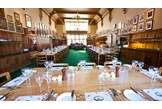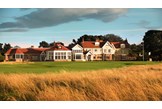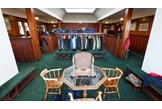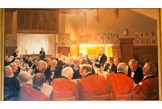Behind closed doors: A look inside Muirfield
Published: Last updated:
As entrances go, Magnolia Lane is something special. The canopy of 61 magnolias that frame the 330-yard approach between Augusta National’s gated entrance and its sumptuous colonial-style clubhouse perfectly define the beauty, majesty and reverance of one of golf’s most iconic amphitheatres.
Yet some would argue that, for real golfers, the walk from the car park, along Duncur Road and then onwards to the imposing gates of the Honourable Company of Edinburgh Golfers is as spine-tingling as it gets. With the sound of flight bags and spikes dragging across the tarmac and the wind whistling through the trees, the 200-yard pilgrimage offers tantalising glimpses through wrought iron lattice of Muirfield’s fluttering flags and traditionally-clad golfers striding across the links in jovial fashion.
Pushing against the heavy iron gate, one enters Muirfield in hushed deference. The world’s great golf clubs evoke a unique blend of anticipation, excitement and a not insignificant dose of apprehension. This is, after all, where Tom Watson and Ben Crenshaw were dutifully vilified for playing a couple of extra holes with hickories on a quiet Sunday evening. The fact that Watson had just won the 1980 Open Championship with Crenshaw coming third was of no interest to the club’s notorious secretary P.W.T. “Paddy” Hanmer, a retired Royal Navy captain. Indeed, there are tales of Gary Player, Jack Nicklaus and Payne Stewart all receiving similar treatment. But that was then and this is now according to Muirfield’s outgoing secretary Alastair Brown.
“When I started, one of the main issues was changing the public perception,” he says carefully. “We had always been prone to slipping on banana skins through over eager management of people who came to the club, but a lot of the stories that got into the press were far removed from the reality. I would hope the club is a friendly place to visit – we have certainly removed a lot of the adverse press coverage.” In a reassuring tone, Brown insists the club has become more open and customer orientated during his 10-year tenure. “The objective is that anyone who comes to Muirfield should have one of the golfing days of their lives,” says Brown, who before joining Muirfield had a career in marketing at big brand names like Schweppes and Saatchi & Saatchi. In fact, Brown is one of only a few non-military secretaries to hold office at Muirfield, which explains his outlook.
“And that requires everything to work,” he continues, “so the staff in the locker room who polish your shoes are as important as the dining room staff, the bar staff and the course staff. You have to deliver continually at a very high level.”
This corporate rhetoric is a far cry from the reprimands and scoldings dished out by “Paddy” Hanmer. And right enough, as you enter gingerly through the gates and take in the view over the 18th green with its famous doughnut-shaped bunker, you are met by the official starter, George Smillie, who welcomes you with a sturdy handshake.
The disdainful greeting you may have expected is notably absent and instead you are cordially shown to the locker rooms, which are shared by members and visitors alike. On your way, you pass the secretary’s office, which for many years served as a lookout post from which the club’s executives would monitor on-course behaviour. Today, the door is ajar and two large imposing tables are festooned with the usual paraphernalia associated with running a busy golf club. Throughout the club, there is no delineation between members and non-members – everyone receives the same treatment with each group sharing equal access to the facilities.
The set-up is a welcome change from the solitude of the visitors’ locker room and certainly not what you would expect from what some say is Britain’s stuffiest golf club. “At a lot of other clubs, you are put into a visitors’ locker room and have
a separate bar,” says Brown. “The visitors who come here get exactly the same experience as the members. And they appreciate it.”
The club’s practical arrangements may surprise some. The shared locker room is pleasant but functional with the only distinguishing features being the beautifully preserved antique course maps that adorn the walls and, of course, the collection of blazers and jackets stored on hangers while members, guests and visitors are out playing. It will shock nobody, however, that the club insists on a strict jacket-and-tie dress code inside the clubhouse.
Perhaps a little more baffling, though, is the revelation that the Honourable Company of Edinburgh Golfers should not necessarily be viewed as a golf club. “When I first started here, one of the members told me that I wasn’t the secretary of a golf club, but rather the secretary of a lunch club that happened to have a very good golf course,” Brown says proudly. “For a lot of the members, the clubhouse is more important than the golf course.”
Muirfield has 700 members with 75 living overseas. Although only 125 play regularly, they all love to lunch. Hanmer was once asked how long it took to play Muirfield and he replied, “2½ hours, 2½ hours and 2½ hours”. The journalist challenged him, suggesting he meant 2½ hours for the first nine and 2½ hours for the second. Paddy unremittingly replied, “No. It’s 2½ hours for the morning round, 2½ hours for lunch and 2½ hours for the afternoon round.”
In fact, it is not uncommon for members to play nine or even 18 holes in the morning followed by 18 holes in the afternoon. This is only possible because the club has a universal love of foursomes, perhaps driven by a collective compulsion for long, leisurely lunches. In fact, the idea of ripping round the course in less than three hours is so important that it has been written into the club rules, which state that members should be discouraged from fourballs.
“If you really want the Muirfield experience; you play foursomes; quickly, take your time over lunch and play some more foursomes until it’s safe to drive home,” says Brown mischievously. “When you come to Muirfield, you come for something unique. You play fourballs anywhere. Here, we play foursomes.”
While alternate shots certainly speed things up and can free up time for a bottle of your favourite Pinot Noir over lunch, if you’ve stumped up £195 for the pleasure of playing one of the most revered layouts on the Open Championship rota, you might feel entitled to hit your own ball. For this very reason, visitors are permitted to play fourballs on dedicated visitor days (Tuesdays and Thursdays) with the remaining tee times reserved exclusively for members and guests.
While this arrangement opens up the club to the average punter, it dissuades members from playing on these allocated days because the pace of play duly interrupts the race to lunch. As Brown puts it, “a fourball can cause havoc” amongst members.
The knock-on effect is that if you visit the club on a dedicated visitor day (rather than being invited by a member) you will often share it with other suitably
delighted newbies, but miss out on the friendly banter generated by the club’s cheery members. The rumpus created by a group of guffawing seniors, who clearly enjoy a drop or two at lunch, is one to relish.
“Ring-fencing visitor and members’ days works well,” says Brown. “The majority of visitors who come here want to hit their own ball and take five hours to get round because it’s an Open Championship venue and it is tough. Meanwhile, members want to zip around and get back into the clubhouse. However, members know that unless they want to play fourball and take four or five hours for a round, they shouldn’t come down on a Tuesday or Thursday.”
The line between members and non-members has always been the source of controversy, as Gary Player found when he arrived ahead of the 1959 Open Championship. After being told he couldn’t practise, the eventual winner begged for leniency from the then secretary Colonel Evans-Lombe, pleading that he could see people playing on the course. “Yes”, came the reply, “but they are members.”
Things have certainly moved on since then with visitors being welcomed by staff who are well accustomed to looking after the paying public. The line in the sand still exists, but it is there for practical reasons rather than snobbery. “Once you’re in the clubhouse, you’re part of Muirfield,” says Brown cheerfully. “It’s a very friendly place.”
Perhaps most telling of all is the job description used to attract candidates for the soon-to-be-vacant secretary’s post (Brown leaves on August 31). As well as looking for strong personality and leadership skills, the club seeks “a good communicator who displays honesty and integrity”.




